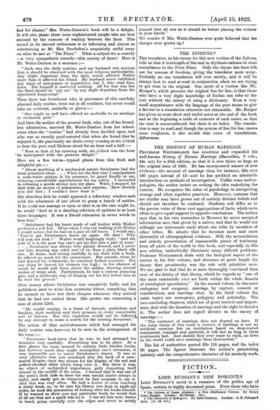THE HISTORY OF HUMAN MARRIAGE. PROFESSOR WESTERMARCE has rewritten and
expanded his well-known History of Human Marriage (Macmillan, 3 vols.,
84s. net) for a fifth edition, so that it is now thrice as large as the original issue of 1891. He has incorporated masses of new evidence—the account of marriage rites, for instance, fills over 160 pages instead of 13—and he has prefixed an admirable introduction on methods of investigation. Unlike some anthro- pologists, the author insists on seeking the idea underlying the custom. He recognizes the value of psychology in interpreting strange and often repulsive practices. Moreover, customs that are similar may have grown out of entirely distinct beliefs and should not therefore be confused. Students will differ as to the precise value of these vast aggregations of facts, which seem often to give equal support to opposite conclusions. The author says that in his own researches in Morocco he never accepted information save that given by a native, and that he would not willingly use statements made about one tribe by members of other tribes. He admits that he becomes more and more distrustful of ethnographical evidence. Still, the accumulation and orderly presentation of innumerable pieces of testimony from all parts of the world in this book, and especially in this new edition, undoubtedly illuminate many difficult problems.
Professor Westermarck deals with the biological aspect of the matter in his first volume, and discusses at great length the theory that promiscuity was the rule with primitive man. We are glad to find that he is more thoroughly convinced than ever of the falsity of that theory, which he regards as " one of the most unscientific ever set forth within the whole domain of sociological speculation." In the second volume he discusses endogamy and exogamy, marriage by capture, consent or consideration, and marriage rites. In the third volume the main topics are monogamy, polygyny and polyandry. The
two concluding chapters, which are of great interest and import- ance, deal with the duration of marriage and the right to dissolve it. The author does not regard divorce as the enemy of
marriage :-
" The existence of marriage does not depend on laws. If the main thesis of this work is correct, if marriage is not an artificial creation but an institution based on deep-rooted sentiments, conjugal and parental, it will last as long as these sentiments last. And should they ever cease to exist, no laws in the world could save marriage from destruction."
The list of authorities quoted fills 118 pages, and the index 90 pages. The figures illustrate the author's painstaking industry and the comprehensive character of his masterly work.


































 Previous page
Previous page